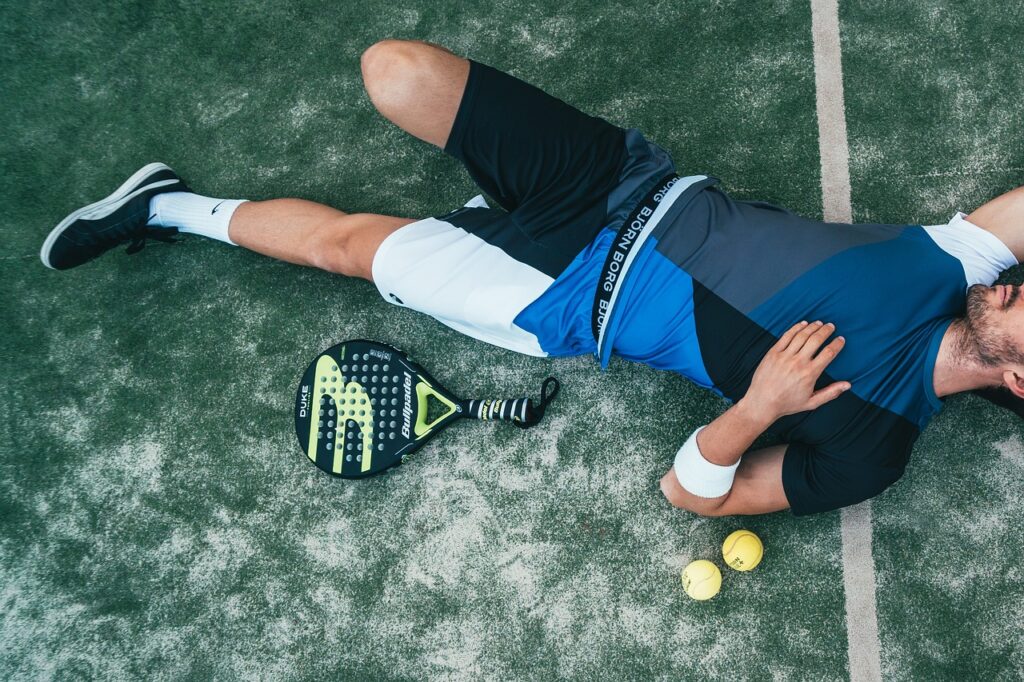Tennis elbow, a common ailment for sports enthusiasts and those with repetitive tasks, can bring considerable discomfort and pain. Whether you’re currently managing it or seeking prevention strategies, this guide delves into the essentials – uncovering the causes, symptoms, and notably, the potential benefits of homeopathy in addressing this condition.

What Is The Meaning Of The Tennis Elbow?
Lateral epicondylitis, commonly known as tennis elbow, is a medical condition impacting tendons linked to the outer elbow. It arises due to the overuse or repetitive strain on forearm muscles and tendons, resulting in microtears and subsequent pain and inflammation.
The Pathology Of Tennis Elbow
Tennis elbow’s pathology centers on the tendons and muscles in the forearm, specifically those linked to the lateral epicondyle of the humerus – a bony prominence on the outer elbow. Overuse of these tendons can result in small tears, triggering inflammation and the distinctive pain characteristic of tennis elbow.
The Causes Of Tennis Elbow
Tennis elbow is often associated with activities that involve repetitive motion of the wrist and forearm. While the name suggests a connection to tennis, this condition can occur in anyone who engages in repetitive tasks such as:
1. Sports Activities: While tennis players can indeed be affected, any sport that involves gripping and swinging, like golf or racquet sports, can lead to tennis elbow.
2. Occupational Risks: Professions involving repetitive hand and wrist actions, like plumbing, carpentry, and painting, elevate the likelihood of tennis elbow.
3. Recreational Factors: Engaging in hobbies such as gardening, knitting, or playing musical instruments can also play a role in the onset of tennis elbow.
The Risk Factors Of Tennis Elbow
Several factors can increase your risk of developing tennis elbow. These include:
1. Age Bracket: Tennis elbow tends to be prevalent among individuals aged 30 to 50, although it can impact people across all age groups.
2. Repetitive Actions: Participation in repetitive hand and wrist movements, particularly without proper technique or equipment, heightens the risk of developing tennis elbow.
3. Strength and Technique: Poor strength in the forearm muscles and improper technique during sports or activities can make you more susceptible to tennis elbow.
The Signs and Symptoms Of Tennis Elbow
Recognizing the signs and symptoms of tennis elbow is crucial for early diagnosis and effective management. Common symptoms include:
1. Pain: The primary symptom is pain on the outer part of the elbow, which can radiate down the forearm.
2. Weakness: You may experience weakness in your grip and difficulties with activities that involve gripping objects.
3. Limited Mobility: Stiffness and a restricted range of motion may manifest in the affected arm.
4. Tender Spot: Tenderness commonly arises at the lateral epicondyle, the bony prominence on the outer side of the elbow.
Differential Diagnosis For Tennis Elbow
Differential diagnosis is essential to rule out other conditions that might mimic tennis elbow. Conditions that share similar symptoms with lateral epicondylitis include:
1. Cervical Radiculopathy: This condition results from nerve compression in the neck and can cause pain and weakness in the arm, which might be mistaken for tennis elbow.
2. Radial Tunnel Syndrome: This nerve-related condition can imitate tennis elbow, inducing pain and weakness in the forearm.
3. Elbow Osteoarthritis: Similar to tennis elbow, arthritis of the elbow brings about pain and stiffness.
4. Bursitis: Inflammation of the bursa sac around the elbow joint can cause pain and discomfort, potentially creating confusion with tennis elbow symptoms.
General Management Of Tennis Elbow
Managing tennis elbow involves a combination of rest, physical therapy, and, in some cases, medical intervention. Here are some general management strategies:
1. Rest: Rest is crucial to allow the tendons to heal. Avoid activities that exacerbate the pain and consider modifications in your daily routine.
2. Physical Therapy: Strengthening forearm muscles, enhancing flexibility, and easing pain can be achieved through tailored exercises in physical therapy.
3. Bracing Support: Utilizing a forearm brace or splint offers support, lessening strain on affected tendons.
4. Pain Management: Over-the-counter pain relievers, like ibuprofen, can assist in handling pain and inflammation.
5. Corticosteroid Injections: In certain instances, healthcare providers may suggest corticosteroid injections to diminish inflammation and alleviate pain.
6. Extracorporeal Shock Wave Therapy: This non-invasive treatment option uses shock waves to stimulate the body’s natural healing processes.
7. Platelet-Rich Plasma (PRP) Therapy: PRP therapy involves injecting a concentrated form of your own blood into the affected area to promote healing.
8. Surgery: Surgical intervention is usually considered as a last resort when conservative treatments have been ineffective. This may involve the removal of damaged tissue or tendon repair.
General Prevention Of Tennis Elbow
Prevention is always better than cure. Some of these preventive tips are:
1. Technique Matters: Whether in sports or repetitive tasks, employing proper technique and suitable equipment minimizes strain on tendons.
2. Strengthen Your Forearm: Integrate exercises that strengthen your forearms into your routine to enhance muscle and tendon resilience.
3. Ergonomics: At work, adjust your workspace and equipment to minimize strain on your forearm muscles.
4. Warm-Up and Stretching: Prior to physical activities, warm up your muscles and perform stretching exercises to prepare your body for action.
5. Rest and Recovery: Allow your body time to recover after strenuous activities. Overuse can lead to injuries.
Exploring Homeopathy for Tennis Elbow
Let’s explore the realm of homeopathy and its potential in managing tennis elbow. Homeopathy, a complementary and alternative medicine, employs highly diluted natural substances to stimulate the body’s inherent healing mechanisms.
Homeopathic Treatments For Tennis Elbow May Include:
1. Rhus Tox: This remedy is often used for joint and muscle pain, making it a potential option for those experiencing discomfort from tennis elbow; Useful for hot, painful swelling in elbow joints with tearing pains in tendons, ligaments, and fasciae. Recommended dose: 3-5 pills, 3 times a day.
2. Arnica: Arnica is known for its anti-inflammatory properties and may be used to alleviate pain and swelling associated with the condition.
3. Bryonia alba: Suitable for tennis elbow with stitching and tearing pains in the muscles around joints, aggravated by motion and relieved by rest. Recommended dose: 3-5 pills, 3 times a day.
4. Calcarea Fluorica: This remedy may be recommended for chronic cases of tennis elbow where there is a history of calcification in the tendons.
Certainly, here are the homeopathic medicines and their key information in short sentence form:
5. Ruta graveolens: Helpful for tennis elbow with pain and stiffness in the elbow and wrists, worsened by lying down and cold, wet weather. Recommended dose: 3-5 pills, 3 times a day.
6. Bellis perennis: Indicated for tennis elbow with soreness of joints, sprains feeling contracted as if from an elastic band around the joint, and great soreness. Recommended dose: Tincture – 3C, 10 drops in half a glass of water, 3 times a day.
7. Bryonia alba: Suitable for tennis elbow with stitching and tearing pains in the muscles around joints, aggravated by motion and relieved by rest. Recommended dose: 3-5 pills, 3 times a day.
Individualized Approach in Homeopathy
Crucially, homeopathic treatments are tailored to the individual. A practitioner considers your unique symptoms, medical history, and overall health before suggesting a remedy. Effectiveness can vary among individuals, and further research is required to solidify homeopathy’s efficacy in treating tennis elbow.

Navigating Tennis Elbow Treatment
Tennis elbow, a prevalent condition with potential daily life impact, often sees conventional treatments and physical therapy as the primary approaches. Some individuals explore homeopathy as a complementary option. Consulting a qualified healthcare professional is crucial to determine the most suitable treatment plan for your specific situation.
Ultimately, whether you choose conventional methods, alternative therapies like homeopathy, or a blend of both, early diagnosis, effective management, and preventive measures are key to regaining mobility and alleviating discomfort associated with tennis elbow. Remember, your health journey is personal, requiring patience and professional guidance. Stay active, informed, and positive on your path to recovery.
Reach out to us for a Consultation
For any queries, reach out to us at contact@homeopathic.ai
This blog is for information purposes. It’s crucial to note that while homeopathy is a centuries-old practice with many adherents worldwide, always consult a qualified homeopath or medical professional before initiating any treatment.





